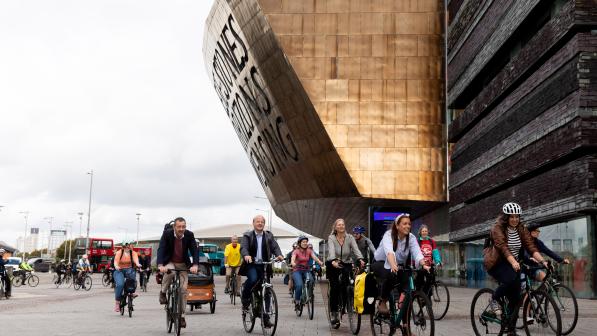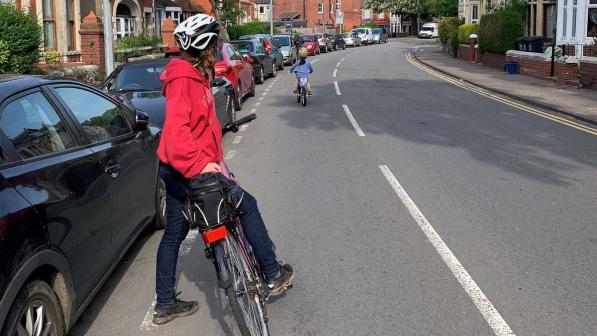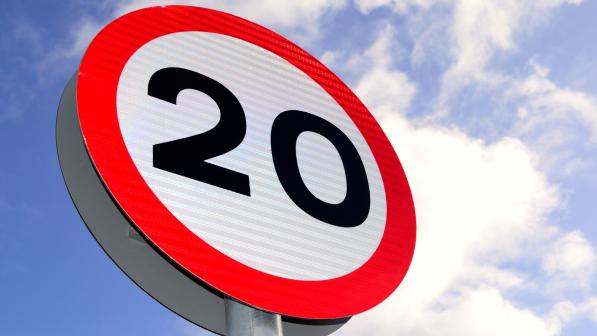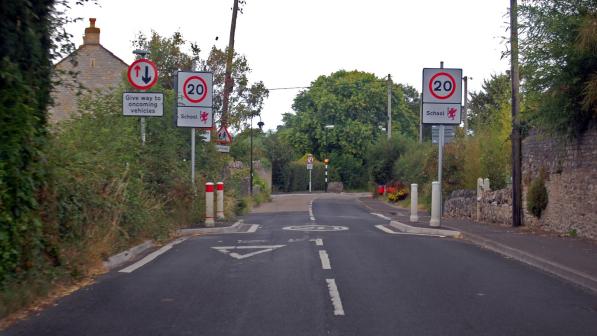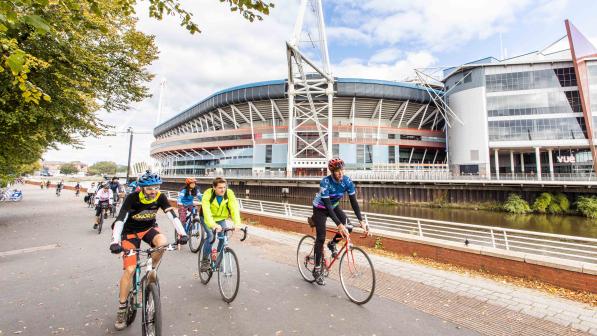20 mph in Wales: why the rules to the exceptions matter

In the past, lowering the speed limit to 20mph on a ‘restricted road’ (or roads), usually in residential and/or built-up areas, wasn’t easy. It involved a legal process at local authority level and, all too often, didn’t happen without gritty community campaigning.
This is still the situation elsewhere in the UK (and may be growing even more problematic in England) but, in Wales, the government has turned the tables: 20mph will become the rule on restricted roads and, subject to the same legal process at local level, 30mph the exception.
Regrettably, though, campaigners can’t relax quite yet. We must now make sure that councils aren’t trying to exempt restricted roads that oughtn’t, in the interests of active travel, to be exempt.
A case in point: the Vale of Glamorgan
Vale Velo Ways exists to help cycling flourish in the Vale of Glamorgan, understands the local area and feels that many of the roads on the council’s exceptions list are, to put it mildly, inappropriate candidates for a higher limit.
Take St Nicholas’ Road in Barry, for example. It’s edged with houses, care homes, two community halls, one of which is a scouts’ lodge, a pub and two churches, while it’s also a popular route to Romilly Park and Knap Gardens. As Vale Velo Ways says, it’s “currently a hostile environment for walkers and cyclists but it doesn't have to be”. (Click down the road on Google Maps to see what they mean).
In other words, continuing to permit drivers to travel up to 30mph here and on similar roads won’t create the safer-feeling and, indeed, safer, local environment for walking and cycling that largely inspired the 20mph legislation in the first place.
Fortunately, like all local authorities, the Vale of Glamorgan Council is obliged to give people the chance to object (or, indeed, agree), although you might conclude otherwise given the early appearance of 30mph signs covered, like unscratched scratch cards, in black plastic.
But, in theory, the higher limit has not yet won through, and Cycling UK, Vale Velo Ways and others have objected.
Which brings us to Traffic Regulation Orders (TROs), government guidance and the principles of consultation.
The TRO: what was the Vale Council thinking?
To exempt roads from the default limit, councils must go through the Traffic Regulation Order (TRO) process under the Road Traffic Regulation Act 1984 (RTRA). Part of that involves giving a ‘statement of reasons’.
The Vale of Glamorgan Council says it considers the roads covered by its Order to be:
“… strategic routes with higher volumes of daily traffic compared to urban residential streets and as such do not meet the criteria or the nature of a road with a speed limit of 20mph. The council considers that the existing 30mph speed limit is an appropriate speed limit in order to maintain a reasonable traffic flow on higher traffic volume strategic routes.”
But, we ask, why don’t the roads in question “meet the criteria or the nature of a road with a speed limit of 20mph”?
Why didn’t the council’s Statement of Reasons state these reasons?
The RTRA says that councils may make a TRO where it appears to them that it is “expedient” for (among other purposes):
- Avoiding danger to persons or other traffic using the road or any other road or for preventing the likelihood of any such danger arising
- Preventing damage to the road or to any building on or near the road
- Facilitating the passage on the road or any other road of any class of traffic (including pedestrians)
- Preserving or improving the amenities of the area through which the road runs
These statutory – statutory, note – purposes seem to us especially pertinent to any proposal to except a restricted road from the default 20mph. But we can’t see any trace of them in the Vale’s statement.
Who’ll be avoiding danger? What damage will 30mph be preventing? What amenities will it preserve? How will maintaining a “reasonable traffic flow” by sticking another 10mph on the new national speed limit for this type of road facilitate the passage of pedestrians and cyclists?
And what about the council’s duty (RTRA, s.122 ) to “secure the expeditious, convenient and safe movement of vehicular and other traffic (including pedestrians)”?
Genuinely, we’d like to know.
Cycling UK and indeed others can only respond to the information provided. It is unreasonable and unfair to require anyone to respond to matters, evidence, or things that were in the minds of council officers when they launched this consultation but failed to set out accurately or at all within the Statement of Reasons or accompanying documents
Duncan Dollimore, head of campaigns, Cycling UK
Government guidance: what was the Vale of Glamorgan Council thinking?
We’d also like to know whether the Vale asked itself the two principal questions the government’s guidance expects it to ask about the roads it’s thinking of exempting:
Question A: Are there significant numbers (or potential numbers, if speeds were lower) of pedestrians and cyclists travelling along or across the road?
If the answer to A is ‘no’ then an exception for a 30mph speed limit may be appropriate.
Question B: If the answer to A is ‘yes’, are the pedestrians and cyclists mixing with motor traffic?
If the answer to B is ‘no’ then a 30mph speed limit exception may be appropriate.
If the answer to B is ‘yes’ then a 20mph speed limit will be appropriate unless the robust and evidenced application of local factors indicates otherwise.
Did, for instance, the council ask itself these questions about Pontypridd Road and Gladstone Road, also in Barry, not only heavily residential but also missing links in a safe active travel network there?
Vale Velo Ways tells us that: “These roads give a clear yes to both of the Principal Questions.
“Both are wide avenues with at least half their width devoted to the storage of motor vehicles. The only nod to active travel is an occasional blue rectangle ‘advisory route for cyclists’ sign. They’re hostile places to travel if you’re not in a motor vehicle.”
And is the council demonstrably sure it wasn’t influenced by existing traffic speeds, which the guidance expects it not to be?
Again, we’d genuinely like to know.
The Vale of Glamorgan is so very close to doing the right thing for active travel – but it’s not there yet; their strategic planning is still focused on preserving the dominance of motor traffic
Olly Leonard, Vale Velo Ways

The consultation: what was the Vale of Glamorgan Council thinking?
How does all this lack of informative evidence, not to mention the pre-emptive 30mph signage, sit with the Gunning Principles on consultation, principles prescribing that a public body must consult before it’s made up its mind and put forward sufficient reasons to permit ‘intelligent consideration’ and response?
So, not only would we genuinely like answers to all our questions, but we also feel we have every right to them and, in fact, shouldn’t have to ask.
The rest of Wales
In Wales, this isn’t any longer about arguing the case for a 20mph default limit on restricted roads. That’s been argued, triumphantly, and there’s a law to show for it.
And neither is this about saying that there can’t possibly be a good case for an exception – there can.
This is what it’s about: making sure that any case for bucking the 20mph default for certain roads, or sections of them, is robust, clear and evidenced, and that consultations illuminate the public about a council’s thinking, rather than keeping them in the dark.
This is vital not just for the success of 20mph in the Vale of Glamorgan, but all over Wales where, alarmingly, we hear some counties are also trying to exempt roads that oughtn’t to be exempt.
Take action
Happily, there’s a map of earmarked exceptions to 20mph in Wales, so do check it to see if you agree with them in your area.
If you find that your council is making mass TRO applications or is proposing completely inappropriate exemptions, we’d like to hear from you – please email us at: [email protected].
If you need to object to your council’s proposals, our response to the Vale of Glamorgan may be useful as a precedent (it’s attached below).
Also, if this plea inspires you, please do think about joining our local campaigning hive, Cycling UK’s Cycle Advocacy Network.
If you’d like to contact Vale Velo Ways, the email is: [email protected].
